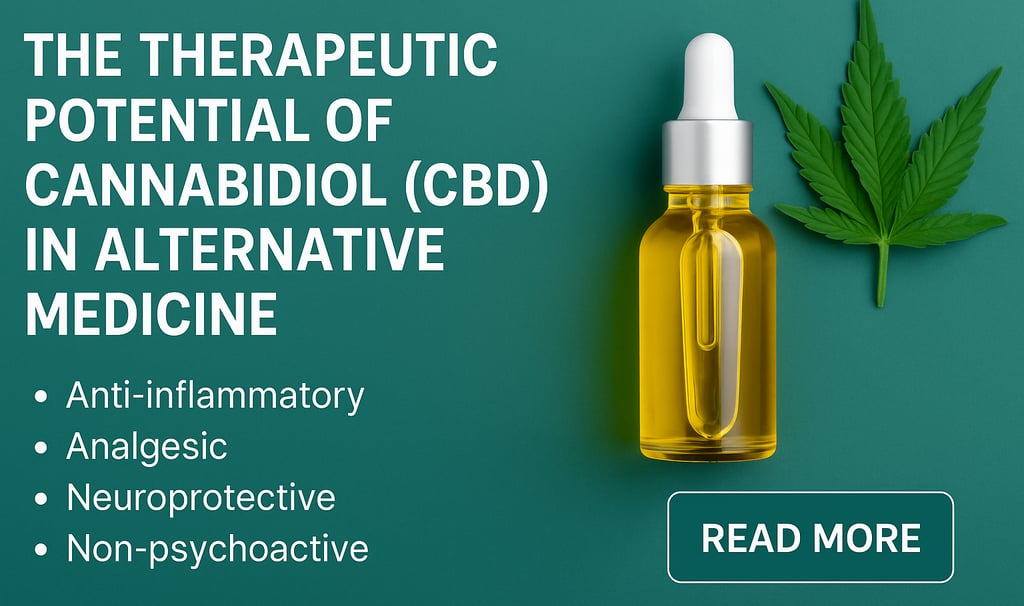The Therapeutic Potential of Cannabidiol (CBD) in Alternative Medicine
Cannabidiol (CBD) has emerged as a promising compound in integrative medicine, offering anti-inflammatory, analgesic, and neuroprotective properties without psychoactive effects. This article explores its mechanisms of action, clinical applications, recommended dosages, and safety considerations, backed by scientific research.


First isolated in 1963, Cannabidiol (CBD) has rapidly gained attention as one of the most studied non-psychoactive compounds in the cannabis plant. Unlike tetrahydrocannabinol (THC), CBD does not produce mind-altering effects, making it an attractive option for therapeutic use in various health conditions. Today, CBD is being widely explored for its potential role in managing chronic pain, inflammation, neurological disorders, and anxiety-related conditions.
How Does CBD Work in the Body?
CBD interacts with the endocannabinoid system (ECS), a complex signaling network responsible for maintaining physiological homeostasis. While CBD exhibits low affinity for CB1 receptors (primarily located in the central nervous system), it modulates their activity, mitigating some of the psychoactive effects of THC. Conversely, CBD acts as an inverse agonist at CB2 receptors, prevalent in peripheral tissues and immune cells, contributing to its anti-inflammatory effects.
Key mechanisms include:
Modulation of CB1 activity, reducing THC-induced psychoactivity.
5-HT1A receptor activation, promoting anxiolytic effects.
Antagonism of GPR3 and GPR6 receptors, linked to Alzheimer’s and Parkinson’s disease pathways.
Antioxidant properties, reducing oxidative stress more effectively than Vitamin C or E in certain contexts.
Therapeutic Applications of CBD
CBD demonstrates promising benefits in a wide range of clinical scenarios:
Chronic pain and inflammation (e.g., arthritis, neuropathic pain).
Neurological disorders, including multiple sclerosis spasticity, Parkinson’s disease, and epilepsy.
Psychiatric conditions, such as generalized anxiety disorder, PTSD, and depression.
Sleep regulation, offering potential for managing insomnia.
Adjunctive oncology care, due to anti-nausea and possible anti-proliferative effects.
Topical CBD applications may provide relief from localized pain, dermatological inflammation, and conditions like psoriasis and eczema.
Dosing Guidelines
Determining an optimal dose requires individualized consideration based on weight, condition severity, and patient response. General guidance includes:
Microdose (0.5–20 mg/day): for mild anxiety, sleep issues, and mood regulation.
Standard dose (10–100 mg/day): for chronic pain, inflammation, and neurological conditions.
CBD should always be introduced gradually, starting at the lowest effective dose and titrating upward while monitoring tolerance and efficacy.
Safety and Drug Interactions
While CBD is generally well tolerated, it is a potent inhibitor of cytochrome P450 enzymes, which can interfere with the metabolism of various medications (e.g., anticoagulants, antiepileptics). Clinical supervision is recommended before initiating CBD therapy, especially in poly-medicated patients.
Conclusion
CBD represents a powerful therapeutic tool in alternative and integrative medicine. Its non-psychoactive profile, combined with its broad pharmacological activity, positions it as a valuable adjunct in managing pain, inflammation, and neurological disorders. However, due diligence regarding dosing, quality control, and drug interactions remains essential for safe and effective use.
References (Peer-Reviewed Sources)
Devinsky O., et al. Cannabidiol in patients with treatment-resistant epilepsy: an open-label interventional trial. Lancet Neurol. 2016.
Iffland K., Grotenhermen F. An update on safety and side effects of cannabidiol: a review of clinical data and relevant animal studies. Cannabis Cannabinoid Res. 2017.
Pisanti S., et al. Cannabidiol: State of the art and new challenges for therapeutic applications. Pharmacol Ther. 2017.
Giacoppo S., et al. Cannabinoids: new promising agents in the treatment of neurological diseases. Neurotherapeutics. 2014.
Zuardi AW. Cannabidiol: from an inactive cannabinoid to a drug with wide spectrum of action. Rev Bras Psiquiatr. 2008.
